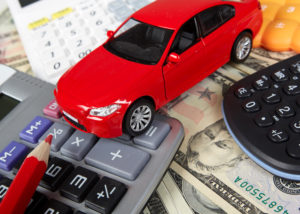After years of record lows, interest rates are on the rise again — but the Federal Reserve’s 25-basis-point hike in June has yet to send shockwaves through the industry. However, further rate increases — combined with rising gas and new-car prices, looming tariffs, and lengthening loan terms — have put the industry on track for a jolt.
“Lenders could see their bottom line squeezed because the federal funds rate influences the price of credit,” Michael Vogan, lead auto economist at Moody’s Analytics, told Auto Finance News. “How much do you fund to the consumer? You’re hamstrung depending on the way the market is.”
The Federal Reserve controls interest rates, raising or lowering them to stabilize the economy and combat inflation. Before the Great Recession sent the economy into a tailspin, interest rates had been on the rise, peaking at 5.25% in 2006. By December 2008, rates hit a record low of 0.25% — the lowest possible figure.
Now, the economy — and the auto finance industry — are in the late stages of recovery. After a decade, the unemployment rate is at its lowest since 2000, consumer confidence is up, and new-car sales have reached pre-recession levels. The rising rates, too, indicate that the industry is in the process of healing.
“We do believe, as a firm, that there will be a few more rate increases this year,” Bruce Jackson, head of dealer services at JPMorgan Chase & Co., told AFN. “We believe that the tailwind behind that is that consumer confidence is high, and we have very low unemployment, so availability of credit is very robust. All these things will certainly mitigate anything in the form of an interest rate increase.”
True, the current 2% fed funds rate is still the lowest it’s been in eight years. However, the Fed has indicated that it will raise rates twice more by yearend and another five times through 2020.
“The marginal impact from a single hike isn’t going to influence consumer behavior,” Vogan added. “That being said, the trend of interest rates will. Every time they raise rates, it’s a signal that they are committed to their plan.”
Industry reaction to the anticipated rate hikes is anything but certain.
Maxed-Out Loan Terms
Traditionally, financial institutions have combated higher interest rates — and rising new-car prices — by extending loan terms. But terms are reaching a point where it becomes unhealthy to lengthen them further.
In the first quarter, average loan terms were 69 months, according to Experian’s State of the Automotive Finance Market report. Comparatively, loan terms averaged 63 months in 2008.
To date, lenders have been willing to offer these longer terms, with some closing in on 100 months. But at some point, longer terms become untenable and risky.
“96-month terms are not sustainable for the industry,” said Andy Crews, president and chief executive of Manchester, N.H.-based Autofair Auto Group. “It’s not good for customers or us as a dealer body. Having cars out there with that much depreciating value just to make a monthly payment isn’t healthy.”
For lenders, longer terms increase the chances consumers will default, driving delinquency rates higher. Extended terms also boost the likelihood that vehicle values fall short of amounts owed, sending more vehicles underwater.
With the option of further extending loan terms off the table, how are lenders supposed to adjust for higher interest rates? The short answer: Options are limited.
“Automakers and their finance arms don’t have too many other resources to address the affordability of these issues — nothing that’s ultimately super convenient to the shoppers out there,” said Jeremy Acevedo, manager of industry analysis at Edmunds. “They can require a larger down payment, or shoppers can buy fewer cars, but there are not too many more resources that automakers have to facilitate the ongoing growth of transaction prices.”
Historically, dealers and OEMs have addressed price changes through incentives and inventory mix, JPMorgan’s Jackson said. Other tactics include lowering vehicle sticker prices. However, with OEMs such as Ford Motor Co. and Fiat Chrysler Automobiles limiting production of certain models, vehicle prices will likely rise further.
“The thing that people should be concerned about is the sticker price of new cars, particularly as manufacturers are reducing the number of affordable cars they are making,” Chuck Berend, director of U.S. auto lending at BBVA Compass Bank, previously told AFN. “The average ticket price on a car is just going to keep going up, and that creates a real problem — especially in a rising rate environment.”
With higher rates looming, and lenders facing limited options to underwrite loans for increasingly expensive cars, the market will likely contract, prompting a decline in vehicle sales.
“As vehicles become a more expensive proposition, and if they really do fall off a cliff with rising interest rates as well as the tariffs, those are the kinds of things that would cause the market to contract,” Acevedo said. “Demand would go down because prices would go up.”
Tariffs and Other Looming Threats
Should the Fed continue its pace of 25-basis-point increases through yearend, the fed funds rate would be 2.50% — about three percentage points below the midyear 2006 level. But interest rates are only one element of the impending scenario.
“If anything needs to be watched out for more than interest rates, it would be two things,” Chase’s Jackson said. “It would be the political landscape and the tariffs, just because it’s unknown. And, two, gas prices. Those are going to be watch items that people will continue to observe.”
In March, President Donald Trump proposed a 25% tariff on steel imports and a 10% tariff on aluminum imports. If the tariffs are enacted, new-vehicle sales could drop by 2 million units, warned Cody Lusk, chief executive of American International Automobile Dealers Association. The tariffs would have global ramifications, affecting import and export — and, subsequently, pricing — of cars and parts in the U.S. and abroad.
Meanwhile, gas prices have also been rising. The national average for a gallon of gas rose half a cent year over year reaching $2.82 in July, a number unseen since summer 2015, according to online gas station database GasBuddy.
As consumers turn to bigger vehicles such as trucks and SUVs, higher gas prices add to the industry’s challenges.
With the recession still visible in the rearview mirror, lenders remain cautious of potential red flags.
“As an industry, we are watching,” Jackson said. “We certainly watch interest rates, but we also watch consumer confidence, availability of credit, the political landscape such as the tariffs and what that impact would be. This industry has always dealt with headwinds as they arise, and we’ve watched consumers, manufacturers, and dealers all be very resilient through any kind of interest rate period.”
Source : AutoFinanceNews














